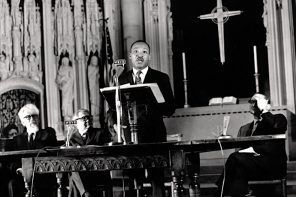Songs for the Butcher’s Daughter was recently named the 2008 winner of the National Jewish Book Award in fiction. – ed.
Peter Manseau’s audacious debut novel announces itself as an unlikely literary “collaboration” between a nonagenarian Jewish immigrant and his 21-year-old gentile translator, telling “the untold story of the greatest Yiddish poet in America.”
And a very unlikely story it is. Part scrappy immigrant’s tale, part magical realist love story, Manseau’s tragicomic epic recounts the life and times of Itsik Malpesh, born in Kishinev, Moldova, in the midst of the 1904 Easter pogrom.
Young Malpesh writes a poem that results in his father’s arrest, and his own exile to Odessa. He becomes a printer’s apprentice, and ends up being shipped off (literally, in a trunk full of printer’s blocks) to the New World, where he finds work in a sweatshop, sewing up garments alongside a motley assortment of Yiddish poets and comedians, who, between their labors, compose lyrics and jokes in their mamaloshen, resisting the pressures to leave Yiddish behind and become English-speaking “real Americans.”
The main subject of Malpesh’s literary output is Sasha Bimko, the defiant presence at his birth, the little girl with the raised fist who, according the to family legend, warded off the pogromists and who always seems one step ahead of him. Malpesh, convinced that Sasha is his bashert, his destiny, composes poem after poem, hoping to conjure her up by means of his words.
“Make words your homeland…”
Yiddish, for Manseau’s characters, is not merely a language, but a Weltangshaung, a “portable homeland,” as Heine might have put it. As one of Manseau’s characters recommends, “Make words your homeland, Itsik. Make them your lover as well. I swear to you, if you do, you will never be homeless and you will never be heartbroken. You will rise each morning and know that the world is yours, no matter in which corner of it you wake.”
Yet the language is a homeland that is disappearing around them, fast slipping away, to be destroyed in the furnaces of the Shoah, overcome by the emergence of the Hebrew state, dissolved in the American melting pot—events that are outside the frame of Manseau’s book while still haunting its pages. As Malpesh’s tutor warns his former pupil: “Yiddish is not long for this world.”
How does a young gentile writer engage in such an act of literary daring—the technical term is chutzpah—to fabricate the memoirs of the “last” (and “greatest”) Yiddish poet, to trespass upon the territory of the great Yiddish writers of the twentieth century, such as Isaac Bashevis Singer, Sholem Aleichem, I. L. Peretz, and Lamed Shapiro?
Manseau, whose previous books include his family memoir Vows: The Story of a Priest, a Nun, and their Son, and Killing the Buddha, co-edited with Jeff Sharlet, has done his homework, having worked for several years at the National Yiddish Book Center in western Massachusetts collecting and cataloging old, forgotten Yiddish volumes, immersing himself in the language and literature of Eastern European Jews. Manseau has taken the stories he has heard and read, especially those of a generation of sweatshop workers on the Lower East Side who spent their free moments composing Yiddish literature, and woven them into a fantasy of love and loss, of a woman and of a language, of the mystery of bashert.
Manseau himself is clearly aware of the boldness, or perhaps recklessness, of his endeavor, cleverly integrating into the novel a sort of apologia. Interspersed with the tale of Malpesh’s life are a series of “Translator’s Notes,” which not only frame the memoir, providing, in the voice of a precocious graduate student, historical context and literary antecedents, discussions of the problematics and treacheries of translation, but also describe the translator’s own journey—spiritual, literary, and erotic—his encounter with Malpesh and his struggles as a translator. (These notes also allow the reader to puzzle over a fictional translator pontificating the difficulties of rendering a fictional memoir.)
As the novel progresses and the translator’s story becomes more and more intertwined with Malpesh’s, it becomes clear that these two are bashert—the old Jewish poet and the budding gentile Yiddish enthusiast destined for one another.
In the coincidence of Malpesh’s memoir and the translator’s Bildungsroman, Manseau has turned his outsider status into the novel’s ethical problem: his unnamed alter-ego, a lapsing Catholic with a developing taste for Yiddish, passes as a Jew to schmooze elderly donors and to seduce his co-worker, Clara Feld, a former high school tennis star from New Jersey who had rediscovered her Jewishness at Mount Holyoke College and has become a somewhat fanatical ba’alat teshuva, estranged from her parents and newly-Mormon brother.
“I have learned the language to become something new,” the translator tells the poet. The outsider posing as insider, the gentile who passes as a Jew, is in a way the inverse of the Jewish drama of assimilation, the so-called “ordeal of civility.” While such passing comes easily for Malpesh’s translator, it leads to a struggle expressed in the translator’s sustained self-consciousness and outright anxiety about the risks of taking upon himself the task of rendering Malpesh’s story and verses, scribbled in a series of accounting ledgers, into English. The paradox is that, by doing so, by saving them, he is inevitably betraying them, making the old Jew’s experience his own:
The translator transforms the original work, yes, but where did the original come from? It is often and rightly said that translation is interpretation. But is a poem, too, any more than an interpretation of experience? If both original and translation are works of interpretation, how does one know where the translation begins and the poem ends?
What emerges in the course of the novel is a sense of the tense, historically fraught relationship between Christians and Jews, and the dangers and misunderstandings bound up even in their creative encounter. Discussing his predecessors and the difficulty of their task, Malpesh’s American translator himself remarks that
Regardless of the context, it would seem that whenever a non-Jew and a Jew speak Yiddish, the stakes are high from the first word to the last. Lines of linguistic, ethnic, and religious identity have been crossed, and thus an expectation is created that other boundaries may be broken: families will be challenged, authority will be defied, sometimes blood will be spilled.
This troubling theme, reenacted in the budding relationships between the translator, Clara and Malpesh, reverberates throughout Songs for the Butcher’s Daughter, and is the most original aspect of the novel. Manseau has some fun here: Clara, the translator’s would-be love interest, is neurotically allergic to all things Christian—upon learning that her beloved prayer book is really a Yiddish translation of the New Testament, she hurls it violently across the room as if would infect her. When she discovers that her boyfriend is really a Catholic, well, one might say that all hell breaks loose.
But it’s deadly serious business, and it’s to Manseau’s credit that he doesn’t flinch from it, but allows himself to stare deeply into the site of Jewish Christophobia. If Clara’s reactions appear comical and histrionic, they serve as counterpoint to the all-too-real fears of Malpesh, whose life is pockmarked by the traumas of anti-Jewish violence. (Even the brave Sasha Bimko, who spends her last years engaged in interfaith dialogue in Jerusalem, is not immune to such terrors.)
And that is why Hershl Shveig—the shy, pious Jewish boy kidnapped by Christians intent on saving his soul and selling his body, the Yiddish translator of the New Testament and would-be apostle to the immigrant Jews of the Lower East Side, enlisted by Malpesh to render his poems into English and to thereby earn him literary fame—emerges as the most tragic character of the novel. Cutting a ridiculous figure in his white suit and white shoes, Manseau draws him as a creature driven by resentment; taunted and beaten by other Jewish children, he freely turns and joins their oppressors. His work on a Yiddish translation of the New Testament is regarded by Malpesh and his fellow sweatshop poets as a forging of a powerful weapon to be deployed against the Jews, and a betrayal of the Yiddish language itself. Manseau shows that translation can be a way to understanding, of tearing down walls between people and cultures, but it can also be a dangerous, transgressive act.
Given the richness and complexity of the novel’s relationships and themes, its tricky postmodern structure, and its competing narratives, it is surprising that Manseau chooses to bring his novel to such a tidy conclusion. One senses that Manseau wants his characters to become reconciled to one another and to their untidy histories, to demonstrate in his fiction that the historical hatreds and suspicions between Jews and Christians can indeed be overcome. Yet, as Sasha Bimko herself seems to indicate in the novel’s closing pages, overcoming history isn’t so easy, even for those who wish to do so.




